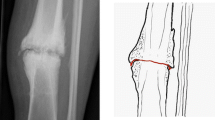Abstract
Seventy patients with 72 conservatively treated tibial plateau fractures were re-examined after an average of 5/34 years. Among 55 fractured knees with a primary articular depression of 1–20 mm, the depression was still present radiographically in 47 knees. No correlation existed between the persistent radiographic depression and function of the knee. Moderate to severe osteoarthrosis was found in 10 knees; in five of these the osteoarthrosis was of clinical importance. More than 10 degrees of valgus/varus deformity was present in two knees. In two patients osteotomy had been performed to correct deformity. It is concluded that a persisten radiographic articular depression is of no clinical importance in tibial plateau fractures treated by conservative methods, which include early movement of the knee. The radiographic examination, however is, useful in the evaluation of valgus/varus deformity and osteoarthrosis.
Similar content being viewed by others
References
Ahlbäck S, Rydberg J (1980) Röntgenologisk klassifikation och undersöknings teknik vid gonartros. Läkartidningen 77:2091
Apley AG (1956) Fractures of the lateral tibial condyle treated by skeletal traction and early mobilisation. J Bone Joint Surg [Br] 38:699
Blokker CP, Rorabeck CH, Bourne RB (1984) Tibial plateau fractures. An analysis of the results of treatment in 60 patients. Clin Orthop 182:193
Burri C, Bartzke G, Coldewey J, Muggler E (1979) Fractures of the tibial plateau. Clin Orthop 138:84
Dovey H, Heerfordt J (1971) Tibial condyle fractures. Acta Chir Scand 137:521
Drennan DB, Locher FG, Maylahn DJ (1979) Fractures of the tibial plateau. J Bone Joint Surg [Am] 61:989
Editorial Comment (1979) Clin Orthop 138:12
Hohl M, Luck V (1956) Fractures of the tibial condyle. A clinical and experimental study. J Bone Joint Surg [Am] 38:1001
Holz U, Märklin H-M, Weller S (1985) Ergebniss nach operativer Versorgung von Tibiakopffrakturen. Unfallchirurgie 88:519
Marwah V, Gadegone WM, Magarkar DS (1985) The treatment of fractures of the tibial plateau by skeletal traction and early mobilisation. Int Orthop 9:217
Roberts JM (1968) Fractures of the condyles of the tibia. J Bone Joint Surg [Am] 50:1505
Salter RB, Simmonds DF, Malcolm BW, Rumble EJ, MacMichael DC (1975) The effect of continuous passive motion on healing of articular cartilage defects. An experimental investigation in rabbits (abstract). J Bone Joint Surg [Am] 57:570
Schatzker J, McBroom R, Bruce D (1979) The tibial plateau fracture. The Toronto Experience 1968–1975. Clin Orthop 138:94
Author information
Authors and Affiliations
Rights and permissions
About this article
Cite this article
Jensen, D.B., Bjerg-Nielsen, A. & Laursen, N. Conventional radiographic examination in the evaluation of sequelae after tibial plateau fractures. Skeletal Radiol 17, 330–332 (1988). https://doi.org/10.1007/BF00367177
Issue Date:
DOI: https://doi.org/10.1007/BF00367177




